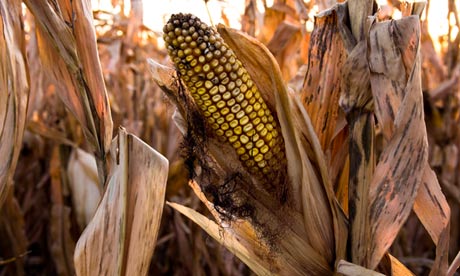As the UN and Oxfam warn of the dangers ahead, expert analyst Lester Brown says time to solve the problem is running out
Brandon Hunnicutt has had a year to remember. The young Nebraskan from Hamilton County farms 2,600 acres of the High Plains with his father and brother. What looked certain in an almost perfect May to be a "phenomenal" harvest of maize and soy beans has turned into a near disaster.
A three-month heatwave and drought with temperatures often well over 38C burned up his crops. He lost a third and was saved only by pumping irrigation water from the aquifer below his farm.
"From 1 July to 1 October we had 4ins of rain and long stretches when we didn't have any. Folk in the east had nothing at all. They've been significantly hurt. We are left wondering whether the same will happen again," he says.
On the other side of the world, Mary Banda, who lives in Mphaka village near Nambuma in Malawi, has had a year during which she has barely been able to feed her children, one of whom has just gone to hospital with malnutrition.
Government health worker Patrick Kamzitu says: "We are seeing more hunger among children. The price of maize has doubled in the last year. Families used to have one or two meals a day; now they are finding it hard to have one."
Hunnicutt and Banda are linked by food. What she must pay for her maize is determined largely by how much farmers such as Brandon grow and export. This year the US maize harvest is down 15% and nearly 40% of what is left has gone to make vehicle fuel. The result is less food than usual on to the international market, high prices and people around the world suffering.
"This situation is not going to go away," says Lester Brown, an environmental analyst and president of the Earth Policy Institute in Washington. In a new book, Full Planet, Empty Plates, he predicts ever increasing food prices, leading to political instability, spreading hunger and, unless governments act, a catastrophic breakdown in food. "Food is the new oil and land is the new gold," he says. "We saw early signs of the food system unravelling in 2008 following an abrupt doubling of world grain prices. As they climbed, exporting countries [such as Russia] began restricting exports to keep their domestic prices down. In response, importing countries panicked and turned to buying or leasing land in other countries to produce food for themselves."
"The result is that a new geopolitics of food has emerged, where the competition for land and water is intensifying and each country is fending for itself."
Brown has been backed by an Oxfam report released last week. It calculated that the land sold or leased to richer countries and speculators in the last decade could have grown enough food to feed a billion people – almost exactly the number of malnourished people in the world today.Nearly 60% of global land deals in the last decade have been to grow crops that can be used for biofuels, says Oxfam. More
